Untitled mural by Jesse McCowan

Jesse McCowan’s mural reflects on war and scientific advancements. The design features several overlapping sections and a fire hose & fire extinguisher feature prominently in the lower right portion of the painted wall. In the upper left corner, two men lean over walls of instruments in a control room, looking over a line of rockets blasting off from Earth. Below them, a soldier gazes towards the viewer and hoists a rifle overhead. Behind the soldier, crumbled buildings trail into a massive mushroom cloud and scenes of fighter jets and tanks streaming into a battlefield. Closer to the bottom of the mural, a nurse carries a tray, while, behind her, a boy begs on his knees. In the lower left corner, a scientist looks purposefully near a rack of test tubes.
McCowan’s mural is reflective of the effects of World War II and the Cold War on Americans’ mindsets. The development and deployment of nuclear weapons (by the US in Japan) brought previously unfathomable levels of destruction to the forefront of politics. These fears were only further compounded by the Cuban Missile Crisis, when the outbreak of war between the US and USSR was narrowly avoided. US-Soviet competition also branched into missile development and scientific advancements like the Space Race, which the USSR won with the launch of Sputnik into orbit. Many young people who came of age in this time were profoundly shaped by this era’s anxieties and advancements.
The placement of McCowan’s mural also speaks to a central tenet of Dr. Biggers’ philosophy towards the Hannah Hall murals. The artist chose to place this mural, which carries a weight of urgency and emergency, in a place where a fire hose and extinguisher would feature prominently in the design. Regarding McCowan’s piece, Dr. Biggers said, “this is a technical aspect of mural painting we must respect…. We must not destroy architecture. But we must relate the painting to the wall and not cut a hole in the wall with the painting.” Other student painters made use of windows and other architectural features in their designs, perhaps drawing from McCowan’s example.
This program is made possible in part by a grant from Humanities Texas, the state affiliate of the National Endowment for the Humanities.
